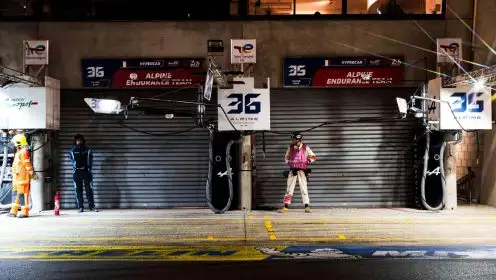Meet the American driver who witnessed two of motorsport’s greatest tragedies

John Fitch drove team-mate Pierre Levegh's car a day before the Frenchman’s death.
Hailing from Indianapolis, Indiana, it would be easy to assume that racer John Fitch gained his fame by competing at the iconic Indianapolis 500. Instead, Fitch became one of the finest American sportscar racers to compete in Europe after World War II — and the one driver to witness two of motorsport’s greatest tragedies.
Though Fitch’s stepfather was an executive at the Stutz Motor Company and therefore grew up surrounded by cars, he found that he actually preferred airplanes. While on a trip through England in 1939, 22-year-old Fitch first volunteered for the Royal Air Force before returning home to join the United States Army Air Corps. Just two months before the war ended, he was shot down and captured as a prisoner of war.
This story is a tie-in to Elizabeth Blackstock’s podcast, “Deadly Passions, Terrible Joys.” Her latest episode centers on the aftermath of the 1955 Le Mans disaster, though she also focuses on the death of seven-year-old Frankie Fazzary at the 1952 Watkins Glen Grand Prix in a previous episode. Fazzary’s death completely transformed the racing world in America.
The experience flying ultra-quick planes turned Fitch on to the beauty of speed, and he bought a British MG-TC to race around New York race tracks before opening an MG dealership in America. Fitch’s skill caught the attention of entrepreneur and driver Briggs Cunningham, who encouraged Fitch to venture to Argentina in 1951 to kick off a racing season with a win at the Gran Premio de Eva Duarte Péron.
Delve into motorsport history
👉 The scandalous story behind the man who introduced glamour to F1
👉 Revealed: Formula 1’s surprising connection to the Great Train Robbery
But tragedy was a common feature of the track in those days, and the following year, Fitch had his first taste of it. The original race course at Watkins Glen, New York was composed of public roads that carved through the town center. Fitch had competed in a race earlier that day, the Seneca Cup, before taking on the Grand Prix.
On the first lap of the Grand Prix, racer Fred Wacker’s red Allard leapt into action up Old Corning Hill, but two Cunningham roadsters — one driven by Briggs Cunningham and the other by John Fitch — tailed close behind. Nearing the end of the first lap, Cunningham had taken the lead, and Fitch was just behind him while Wacker tailed just behind and to the left.
Fitch moved into the left hand lane just as Wacker attempted to pass Fitch on the outside in what had been deemed a no-passing zone. He veered to the right to give Wacker space, but Wacker veered to the left to attempt to do the same.
Wacker’s tires left the track just in front of a crowd of packed spectators separated from the track by a rope. He tried to ease his car out of the way, but it was too late. His Allard’s rear fender cut through the crowd, injuring 12 people and, unfortunately, killing seven-year-old Frankie Fazzary. Fitch heard the noise and turned around to see that disaster had struck.
While Fitch was able to continue racing all around the world in the aftermath of Fazzary’s death, American motorsport was at its crisis point. All racing events held on public roads were canceled all across the United States. While new purpose-built tracks were constructed outside of the city limits, motorsport was briefly confined to private estates or disused airfields like Sebring.
Fitch competed in countless races around the world after that, but his run-ins with danger didn’t end with Watkins Glen. Three years after Fazzary’s death, Fitch entered the 24 Hours of Le Mans as part of the formidable Mercedes-Benz team. His teammate was 47-year-old Pierre Levegh.
At 6:26 p.m., just under three hours into the 1955 running of the 24 Hours of Le Mans, disaster struck. Jaguar driver Mike Hawthorn darted in front of an Austin Healy driven by Lance Macklin. Macklin jerked to the side to avoid making contact, which put him directly in the path of Levegh’s Mercedes-Benz 300 SLR.
Levegh’s car was traveling at over 120 miles per hour when it struck the rear of Macklin’s Austin Healy. The 300 SLR launched into the air and smashed down onto an earthen embankment separating the spectators from the track. The hood, engine, and front suspension flew into the crowd of onlookers. The chassis, made of a highly ignitable magnesium alloy, burst into flames — flames that couldn’t be extinguished with water.
The race continued as medics and police tended to the injured and dead.
John Fitch was stood at his Mercedes pit box when the crash took place, preparing to take over from Levegh. He remained there for an additional 30 minutes after the crash to comfort Levegh’s distraught wife before he left to find a phone in the media center; he had realized his family may have heard of the wreck on the radio, and he wanted to assure them he was safe. There, he learned that 48 people had already been confirmed dead.
When all was said and done, over 80 spectators had been killed, with another 120 injured. Mercedes-Benz withdrew from Le Mans and, at the end of the season, from motorsport overall. Many countries enacted temporary bans on motorsport; Switzerland was one of the last countries to lift that ban, which lasted until 2015.
Fitch was understandably deeply affected by the crash — as were many of those who witnessed it. But having competed in two horrible, motorsport-altering crashes within the span of three years completely changed his understanding of racing.
Rather than simply sit idle, Fitch got to work. Though he had additional racing successes — both as a driver and as Corvette Racing team manager — his greatest contributions to motorsport came in the form of pioneering safety innovations.
Immediately after Le Mans 1955, John Fitch invented the Fitch Barrier. These sand-filled barrels were inspired by a smaller version of the same concept that Fitch had used to protect his tent from strafing during World War II. If a car were to hit one of these barriers, it would absorb the energy of the impact, thereby slowing the car and reducing the possibility of injury.
He also pioneered the Fitch Compression Barrier for oval racing, the Fitch Displaceable Guardrail, and the Fitch Full Driver Capsule. The latter secured a driver’s head to his seat back in a manner similar to the now-ubiquitous HANS device.
Fitch was one of the only men to have endured two horrifying accidents in such a short span of time — but he transformed that tragedy into something positive. Though he witnessed the deaths of many racers and spectators during his career, he also saved thousands of others.
Read next: Drug runners, fraudsters, and scammers: The American criminals who raced at Le Mans





